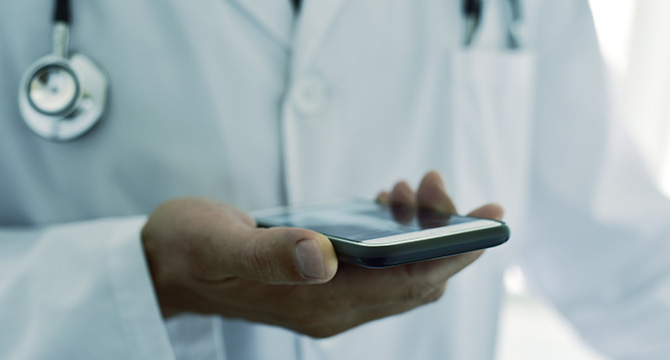Medicare’s New Chronic Care Remote Physiologic Monitoring Codes: Everything You Need to Know

Earlier this year, in a first-of-its-kind move, CMS made remote patient monitoring (RPM) a separately-reimbursable service under Medicare. Now, CMS has proposed three new codes for RPM services, retitled “Chronic Care Remote Physiologic Monitoring,” which do a far better job reflecting how providers can more effectively and efficiently use RPM technology to monitor and manage patient care needs, including chronic care management. If finalized, these three codes would go live January 1, 2019. Until then, CMS is accepting comments on the proposed codes through September 10, 2018.
Medicare’s Current Remote Patient Monitoring Code
Medicare already offers separate reimbursement for RPM services billed under CPT code 99091. That service is defined as the “collection and interpretation of physiologic data (e.g., ECG, blood pressure, glucose monitoring) digitally stored and/or transmitted by the patient and/or caregiver to the physician or other qualified health care professional, qualified by education, training, licensure/regulation (when applicable) requiring a minimum of 30 minutes of time.” It went live for the first time earlier this year (effective January, 2018).
Why the New Codes?
While industry advocates generally applauded CMS for activating RPM reimbursement, they simultaneously recognized CPT 99091 fails to optimally describe how RPM services are furnished using current technology and staffing models. This failure may be due to the fact that CPT 99091 is 16 years old and had never before been a separately payable service. (It is an older code CMS “unbundled” and designated as a separately-payable service.) Indeed, the AMA’s CPT Editorial Panel developed and finalized a set of three new RPM codes in late 2017. These codes (CPT 990X0, 990X1, and 994X9) are what CMS recently proposed activating effective in 2019. The new codes do a far better job accurately reflecting contemporary RPM services.
What Are the New RPM Codes?
The new Chronic Care Remote Physiologic Monitoring codes are:
- CPT code 990X0: “Remote monitoring of physiologic parameter(s) (e.g, weight, blood pressure, pulse oximetry, respiratory flow rate), initial; set-up and patient education on use of equipment.”
- CPT code 990X1: “Remote monitoring of physiologic parameter(s) (eg, weight, blood pressure, pulse oximetry, respiratory flow rate), initial; device(s) supply with daily recording(s) or programmed alert(s) transmission, each 30 days.”
- CPT code 994X9: “Remote physiologic monitoring treatment management services, 20 minutes or more of clinical staff/physician/other qualified healthcare professional time in a calendar month requiring interactive communication with the patient/caregiver during the month.”
How Do the New RPM Codes Differ from the Current CPT 99091?
The three biggest changes between from the new Chronic Care Remote Physiologic Monitoring codes and the current CPT 99091 are as follows:
- 33% Less time required. CPT 99091 requires at least 30 minutes per 30-day period, whereas CPT 994X9 requires only 20 minutes per calendar month (33% less time than CPT 99091). Additionally, the new code is much easier to track because it is based on a calendar month, not 30-day periods. This will more easily align with recordkeeping and claims submission, as CPT 994X9 is also reimbursed on a monthly basis.
- Separate payment for initial set-up and patient education. CPT 99091 does not offer additional reimbursement for the time spent setting up the RPM equipment or educating the patient on its use. But the new CPT 990X0 does, offering separate reimbursement for the work associated with onboarding a new patient, setting up the equipment, and training the patient on same. This is a great decision and will help incentivize providers to start using these technologies with their patients. As further credit to CMS’ vision to promote new technologies, the separate payment under CPT 990X0 is very different from how Medicare reimburses Durable Medical Equipment (DME) suppliers (e.g., CPAP, oxygen, etc.). CMS requires the DME supplier to set-up the equipment at the patient’s home and educate the patient on how to use the equipment, but does not offer separate payment to the supplier for that critical work.
- Clinical staff allowed. CPT 99091 is limited only to “physicians and qualified health care professionals” and does not expressly allow the RPM service to be delivered by clinical staff (e.g., RNs, medical assistants, etc.). This means the physician or qualified health care professional must personally perform (and document) the full 30 minutes per 30-day period, which is a lot of time for these highly trained professionals. For some providers, this is too resource-intensive to justify the $58.68 per month reimbursement rate. The new CPT 994X9 allows RPM services to be performed by clinical staff.
What CMS did not mention in the proposed rule is whether or not CPT 994X9 can be delivered via “incident to” billing under the general supervision of the billing physician. The default rule is that “incident to” billing must be performed under direct supervision (meaning the physician must be present in the office suite and immediately available to provide assistance and direction throughout the time the auxiliary personnel is performing services). However, CMS is allowed to make exceptions, which it did for Chronic Care Management (CCM) services.
Like CCM, most RPM services are most efficiently delivered under general supervision, which does not require the physician and auxiliary personnel to be in the same building at the same time, and the physician could instead exert general supervision via telemedicine. This makes a huge difference in operations and business models, but in order for these new RPM codes to work in the real world, it is near-essential that CMS allow the new RPM codes to be billed “incident to” under general supervision. Ensuring CMS makes this change in connection with the final rule is very important to the success of these new codes.
Chronic Care Remote Physiologic Monitoring is Not a Telehealth Service
Providers frustrated with the labyrinthine and narrow Medicare coverage of telehealth services can take comfort in the fact that RPM is not considered a Medicare telehealth service. Instead, like a physician interpretation of an electrocardiogram or radiological image that has been transmitted electronically, RPM services involve the interpretation of medical information without a direct interaction between the practitioner and beneficiary. As such, Medicare pays for RPM services under the same conditions as in-person physicians’ services with no additional requirements regarding permissible originating sites or use of the telehealth place of service (POS) 02 code. This means Chronic Care Remote Physiologic Monitoring does not require the use of interactive audio-video, nor must the patient be located in a rural area or a qualified originating site. Patients can even receive RPM services in their homes.
What to Do Next?
Here are four things providers and entrepreneurs interested in Chronic Care Remote Physiologic Monitoring should consider now, in order to prepare for this new opportunity:
- Take the time to truly understand, with precision, the billing and supervision rules fundamental to a compliant RPM service model. While a proof of concept is wise, providers should not overly focus on the technology and business development issues until they are confident the model they are “selling” or delivering does, in fact, comply with Medicare billing requirements. Otherwise, they could face significant overpayment liability if a Medicare administrative contractor conducts a post-payment audit and coverage or reimbursement requirements are not met.
- Develop a model business-to-business RPM contract, whether this contract is technology-only, support services-only, or a combination of both.
- Read the Medicare proposed rule and consider submitting comments to CMS during this current open period, explaining why CMS should allow the new RPM codes to be billed “incident to” under general supervision, just like CMS did for CCM services. Do not wait until after the final rule is published, only to complain that CMS did not consider something important; help CMS by informing them through the public comment process.
- Companies currently offering CCM services should be particularly focused on expanding their business lines into RPM. Not only do CCM companies have current customers who can benefit from RPM services, the non-face-to-face technology and clinical integration requirements are fairly similar. Moreover, CCM and RPM can both be separately billed for the same patient in the same month, allowing additional revenue. Pro tip: providers cannot double count the minutes for CCM and RPM, so billing both would require at least 40 minutes per month (20 minutes of CCM and 20 minutes of RPM).
Conclusion
Entrepreneurs and start-ups offering RPM technologies and services should take steps now to understand these new billing opportunities under Medicare. With the forthcoming CPT codes for Chronic Care Remote Physiologic Monitoring, this looks to be an area of significant upside potential over the coming years. In addition, hospitals and providers using RPM and non-face-to-face technologies to develop patient population health and care coordination services should take a serious look at these new codes, and keep abreast of developments that can drive recurring revenue and improve the patient care experience.
For more information on telemedicine, telehealth, virtual care, and other health innovations, including the team, publications, and other materials, visit Foley’s Telemedicine and Digital Health Industry Team and read our 2017 Telemedicine and Digital Health Executive Survey.
